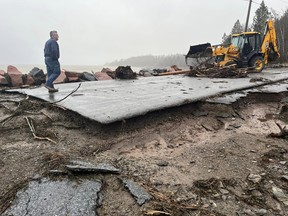Searching for answers in coastal communities
Back to back storms cause damage in southern New Brunswick, prompting calls for action from province, Ottawa

Article content
Grand Manan Mayor Bonnie Morse had a pit at the bottom of her stomach the last few big storms.
During the winds that battered much of southern and central New Brunswick Dec. 18, public wharves and private properties along Grand Manan’s developed eastern coast were swamped.
More recently, storm surges on Jan. 10 and 13 were exceptionally high, with even more seawater penetrating inland, eroding the banks and people’s yards.
“We saw some of the highest tides we’ve seen,” the mayor said. “We saw a lot of water on people’s properties and a lot of our harbours were underwater. We don’t normally see that during storms.”
A dangerous settlement pattern
The main road that cuts north-south along the eastern coast, Route 776, survived the battering but it has been a concern for years. The island’s pioneers preferred the area of the island that slopes gently to the water, not the sheer cliffs that dominate the western coastline.
The settlement pattern puts most of the roadways, homes and businesses in a vulnerable position, as global warming threatens to raise sea levels.
It’s a pretty helpless feeling knowing there’s nothing you can do but wait to see how high the tide comes.
Bonnie Morse
Route 776 ties all the communities on the island together, so if it were cut off, people on the wrong side would have to make do with their boats and ATVs.
“Anyone who lives on the coast is always worried about the big one hitting,” she said. “But certainly, seeing what we saw last week, makes us realize how vulnerable we can be during storms and it’s a pretty helpless feeling knowing there’s nothing you can do but wait to see how high the tide comes.”
‘Nothing’s been done’
Green Party Leader David Coon said Tuesday both Liberal and Progressive Conservative governments in New Brunswick have dilly-dallied too long on protecting shoreline properties and public infrastructure.
This government has abandoned people and left them to their own devices.
David Coon
Besides Grand Manan, coastal properties in Saint Andrews and St. Stephen on the mainland in southwestern New Brunswick were battered by recent storms, which coincided with the high spring or “king” tide, the phenomenon when the earth, moon, and sun are in alignment.
“Nothing’s been done,” Coon said. “This government has abandoned people and left them to their own devices. So you have homeowners and municipalities trying to shore up shoreline. But it’s really a question of public works and infrastructure. There’s a public responsibility to safeguard people’s homes, properties and infrastructure. And this government isn’t doing that. They keep saying we’ll do that after completing a risk assessment. But later is too late for so many communities that are already experiencing the damage that’s being caused by erosion and storm surges.”

Provincial government officials did not respond to requests for interviews with Environment Minister Gary Crossman or Transportation and Infrastructure Minister Richard Ames.
Instead, they released a prepared statement.
“Climate change will continue to impact every part of society, from infrastructure to our health to our natural environment,” wrote Clarissa Andersen. “To address these effects, a thorough, evidence-based strategy will need to be established through the assessment.”
Action promised after 2025
Andersen said that the province’s climate change action plan committed to doing a risk assessment by 2025, followed by an adaptation plan to respond to the identified risks.
The safety of New Brunswickers is of the utmost importance.
Clarissa Andersen
Work on the risk assessment, she said, had already begun and was on track to be released next year.
She added that the Department of Transportation and Infrastructure (DTI) understood the importance of taking swift and decisive action to reduce the impact of climate change.
“DTI also understands that climate conditions have changed since the construction of much of our infrastructure and are seeing its impacts,” she wrote. “The safety of New Brunswickers is of the utmost importance to DTI and the department continues to investigate and pursue federal funding opportunities to advance climate action in the province.”
Coon, however, said both departments knew full well what areas are most vulnerable because past storms have already damaged them. He acknowledged that a detailed risk assessment was important for future planning, but he also argued provincial officials should start making changes immediately.
“This is just a taste of what’s going to get worse,” said the environmentalist. “They don’t need to wait around for the more detailed assessment to help areas that have already shown they are vulnerable.”
A whole lot of coastline
New Brunswick has 5,500 kilometres of coastline and dozens of rivers, with many areas susceptible to flooding and erosion. Bolstering these areas or retreating from them would likely cost billions, in a province with an annual capital budget of just $1 billion.
“There’s no question, because of the climate crisis, this is going to be a big public works project,” Coon said. “Damage caused by the climate crisis is expensive. That’s what economists have been telling governments over and over for years. The failure to act on this is causing real costs. So, yeah, it’s going to be expensive.”
Picturesque Saint Andrews has been sullied by recent weather events. Mayor Brad Henderson said he couldn’t recall a 12-month period in which so many forces damaged the community where he grew up, be it fire, windstorms, or higher than normal tides.
It’s happened in the past, but twice in one week? I don’t remember that ever happening.
Brad Hendersen
In December, people were out of power for up to eight days up to Boxing Day. Last week, two storms hit during the high spring tide, swamping low areas such as the Bar Road, Patrick Street, the Point and Market Square.
“It’s happened in the past, but twice in one week? I don’t remember that ever happening,” he said.

Henderson said his community is so small, it would have a hard time paying the traditional one-third amount for big public infrastructure projects and believes the provincial government should step in.
The Bar Road leads to the tourist destination of Minister’s Island, and he wants the province to help repair the road, whose asphalt was torn up by the latest storms.
“It’s a landing area before you cross to the island. So we’re looking to the government to see if they will not only repair it but build something more durable for these rising sea levels.”
Financial might needed
The Grand Manan mayor said it was time for higher levels of government, with their financial might, to think about ways to protect the island from storm surges and coastal erosion.
“It’s got to be a multi-pronged approach,” she said. “If you look at the roads, for instance, it’s not something the municipality could do on its own. The harbours are federal infrastructure, so there’s a role for Ottawa as well. We need to start talking about what the biggest priorities are and start acting on them so it’s more than just words on a page.”
– with files from Andrew Bates












Postmedia is committed to maintaining a lively but civil forum for discussion. Please keep comments relevant and respectful. Comments may take up to an hour to appear on the site. You will receive an email if there is a reply to your comment, an update to a thread you follow or if a user you follow comments. Visit our Community Guidelines for more information.